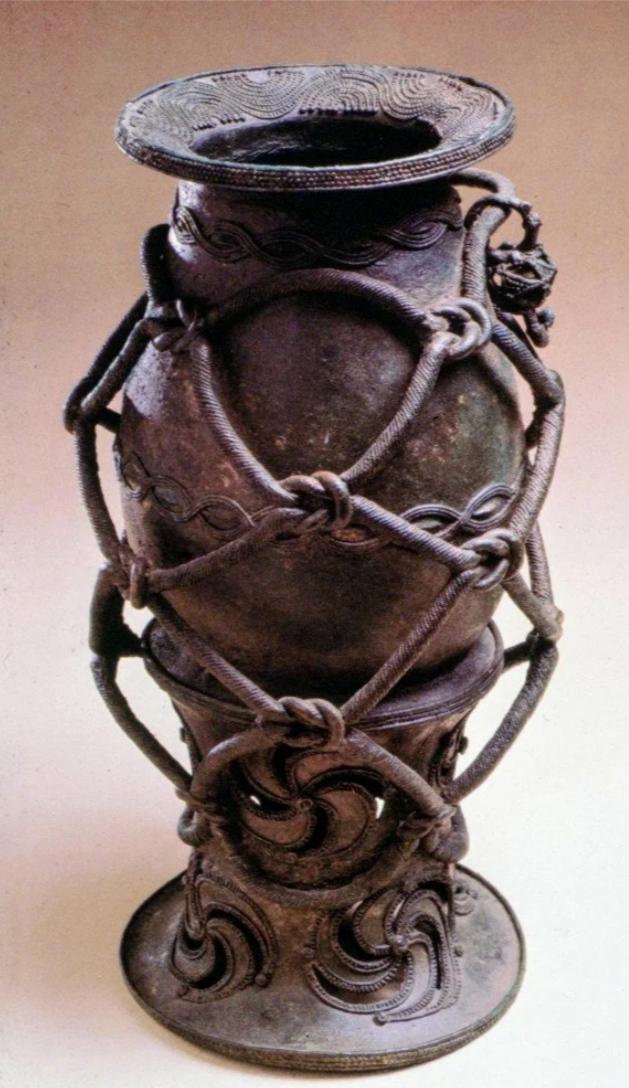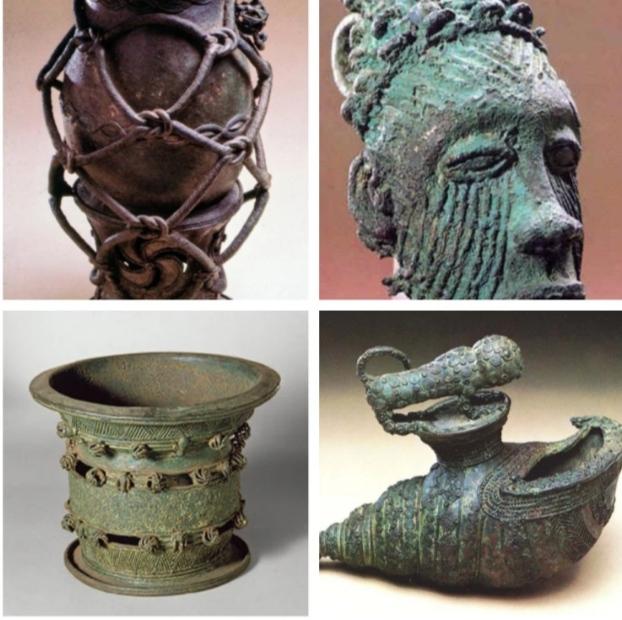igbo ukwu bronzes art history
Isaiah Anozie, Igbo Ukwu Bronzes native of Igbo Ukwu, a village in the current state of Anambra in southeast Nigeria, came across many bronze artifacts while excavating a ditch in his yard in 1938.
A stick, a manila, a pendant showing a face with scarification, a ram’s head, and a semi-circular cup were among them. There are traces of the town’s name’s etymology in those artifacts: Igbo Ukwu, or Great Igbo.
The unexpected finds sparked a great deal of interest, and finally word of them reached the University of Ibadan’s (established in 1948) Archaeology Department. Igbo Ukwu Bronzes was a major discovery when Thurstan Shaw, an archaeologist with the department, finally carried out official excavations, 21 years after the initial discovery in 1959.
Igbo Ukwu bronze objects

Three sites in total were unearthed; they are now known as Igbo Isaiah, Igbo Richard, and Igbo Jonah, after the proprietors of the compounds where the artifacts were discovered.
The excavations revealed that Igbo Isaiah housed a shrine, Igbo Richard contained what appeared to be a royal personnage’s burial chamber, and Igbo Jonah contained a treasure trove of various artifacts, some of which implied long-distance trade with locations as distant as ancient Egypt.
Igbo Ukwu Bronzes oldest artefacts in West Africa, according to carbon dating, date back to the 9th century, or 900 years ago.
An illustration of the excavated burial chamber and placement of the corpse.

More than 400 years had passed since the Igbo Ukwu discovery, during which time European trans-Atlantic slavery had decimated Africa and left it vulnerable to colonial rape.
During that period, many Europeans attempted to defend the horrible crimes committed against Africans by denying their humanity, institutionalizing racism, and arguing that Africans lacked civilization and deserved what they received.
Thus, the Hamitic hypothesis—which discussed a propensity to attribute African achievements to some hypothetical Hamites, light-skinned people from the East—was initially invoked in response to the Igbo Ukwu finds.
Igbo Ukwu Bronzes to the Ife and Benin bronzes created 500 years later, which are actually brass made up only of lead and zinc, the earlier artifacts were genuine bronze formed of alloys of lead, zinc, and copper.
By adopting a lost-wax technique to create products of such delicate artistic beauty that demonstrated significant technical mastery of the metals utilized, the objects demonstrated that their creators were skilled in metallurgy.
More than 400 years had passed since the Igbo Ukwu discovery, during which time European trans-Atlantic slavery had decimated Africa and left it vulnerable to colonial rape.
During that period, many Europeans attempted to defend the horrible crimes committed against Africans by denying their humanity, institutionalizing racism, and arguing that Africans lacked civilization and deserved what they received.
Igbo Ukwu Bronzes, the Hamitic hypothesis—which discussed a propensity to attribute African achievements to some hypothetical Hamites, light-skinned people from the East—was initially invoked in response to the Igbo Ukwu finds.
Igbo Ukwo decorated bronze staff head.

However, the artifacts featured elements of Igbo culture, including igbu ichi scarification marks, ceremonial animals, regional attire, and flora and wildlife. The lack of locally known sources for the copper utilized in the bronzes as an initial justification for local fabrication of the items.
Professors Vincent Chikwendu and Alphonse Umeji of the University of Nigeria, Nsukka’s Archaeology Department conducted studies to refute this claim. They discovered that the copper came from the Igboland region of Abakaliki-Afikpo.
Shaw originally noted that the metal alloys revealed detectable quantities of silver when submitted to chemical examination in Igbo Ukwu, his book on the excavation, which was released in 1970. Paul Craddock of the British Museum’s research lab in the U.K.
later confirmed this, which raised the possibility that the copper utilized came from a single source. In collaboration with R.M. Farquhar of the University of Toronto, Craddock examined samples from abandoned mines in the Abakaliki region and discovered that the lead components and ratios of the ores are identical.
Metal Sources and the Bronzes From Igbo-Ukwu, Nigeria is the title of a joint article by Craddock, Janet Ambers, Duncan R. Hook, Farquhar, Chikwendu, Umeji, and Shaw that was published in the Journal of Field Archaeology (Volume 24, No. 4 (Winter, 1997), pp. 405–429). They offer the clearest proof of the metals’ native sources, as well as of local design and production.
The Nri Epoch
In fact, what the revelations about Igbo culture show is a past in which monarchs had a pride of place that existed in concord and peace with Igbo republicanism, where the necessity to accept collective goals under a kind of priest-king and the need for individualism found a delicate balance.
In every agricultural era, the earth was revered by the Igbo people for its fertility and the bounty it returned for every seed. The Nri priests and monarchs played a significant role in this regard. These priests protected the planet from nso ala violations that would have been harmful to both its sustenance and the dependant human race.
Igbo Ukwu bronze roped pot.

Their complex ceremonies and customs aimed to maintain harmony between people and their surroundings. They were closely related to the progression of the seasons, which were based on a four-day workweek, as well as the growth of organized trade and the accompanying market system (the fundamental tenet of Igboness), which linked a region greater than several contemporary European countries.
The Igbo Republican political system, which acquired significant influence over vast areas through the priest-king system rather than through warfare and conquest, was founded on the concepts of this quasi-religious, political, economic, and philosophical system.https://s.pubmine.com/click4/e9607d3d-8a29-49e4-9a7f-36572c94d394/2RESG6W14EeAjputZBEnMlZSI4XOtQ_aqMqsZUZddtLddVOzUBE5_Uda5c_F11p4g6uoJN9D23qHNKXzq8WlQREvfuvdMTFLHnoePGPKLK8RysJootXiM38TQHt2tr0hlUDEVwLb4PQQkRd7mwOrP7YpNW4LVMj88EI2HLWz9TcfTtJI-Ck-au0//https://www.tumblr.com/explore/trending?source=tumblr_gs_meme5&utm_source=wordads&utm_medium=display&utm_campaign=tumblr_gs&utm_content=houseads_gs_meme5
Before the arrival of the white man and the start of the trans-Atlantic slave trade, which led to the Arochukwu hegemony beginning in the 15th century, all of these were achieved and established. The Igbo Ukwu artifacts allude to the achievements of this horrific era, which resulted in the loss of much of Igbo culture from the heights it had attained in the previous era.


